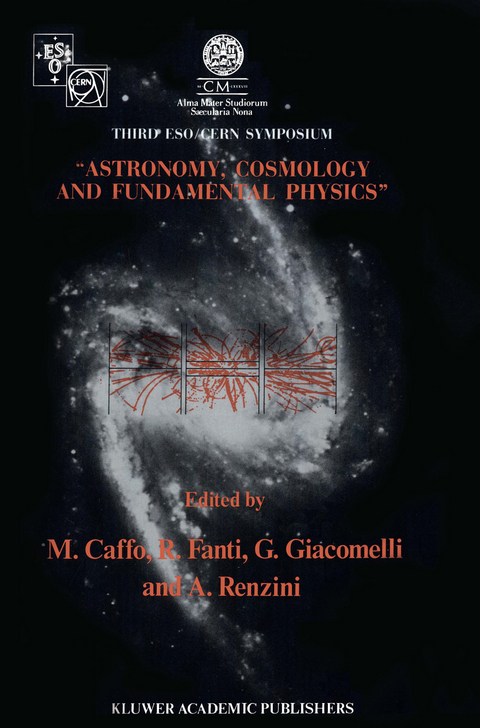
Astronomy, Cosmology and Fundamental Physics
Springer (Verlag)
978-0-7923-0258-2 (ISBN)
- Titel z.Zt. nicht lieferbar
- Versandkostenfrei innerhalb Deutschlands
- Auch auf Rechnung
- Verfügbarkeit in der Filiale vor Ort prüfen
- Artikel merken
Astroparticle Physics (1988).- Cosmological Parameters of the Universe.- Electroweak Physics in 1988.- Lithium-7 as a Cosmological Observable.- Recent Results from the e+e- Colliders TRISTAN and CESR.- The Large-Scale Distribution of Galaxies.- The Cosmic Microwave Background Radiation and the Dog in the Night.- Quark Deconfinement and J/? Suppression in Nuclear Collisions.- A Brief Status Report on the SLAC Linear Collider (SLC).- The Large Scale Structure of the Universe.- Status and Physics of the FERMILAB TEVATRON.- Cosmic Strings and Galaxy Formation: Overview and Recent Results.- Results from the Frejus Experiment.- Superclusters of Galaxies: Fractal Properties.- Underground Physics.- Probing the Universe with Rich Clusters of Galaxies as Giant Gravitational Telescopes.- Dark Matter in Astronomy.- Dark Matter Candidates.- Limits on Wimps from Globular Cluster Stars.- Improved Limits from the Galactic Axion Search.- Low Temperature Detectors for Neutrinos and Dark Matter.- Is there Dark Matter in Elliptical Galaxies?.- Special Session on Supernova 1981A.- Optical Studies of the Supernova 1987A.- Neutrino Astrophysics: Its Birth and Future.- Models of Type II Supernovae and Supernova 1987A.- X-Ray Observation of SN1987A from Ginga.- Models for the X-Ray Emission from Supernova 1987A.- Beyond the Standard Model.- High Redshift Objects.- Concluding Lecture.- Posters.- Hard X-Ray Observation of the Supernova 1987A.- The UA6 Experiment at the CERN Collider.- Precise Determination of the Background Radiation Temperature.- An Age Estimate for the NGC456, 460 and 456 SMC Constellations.- On the Orientation of Spiral Galaxies in the Perseus Supercluster.- Thermal Coupling of the CMBR and the Primordial Gas in the Post-Recombination EPOCH (z ? 1000).- Nearby SpiralGalaxies: Optical and Radio Properties.- Recent Results on Detector Developments for Low Energy Solar Neutrinos and Dark Matter: SSG and DSC Devices.- New Estimates for the C/M Ratio.- Small Scale Isotropy of the Cosmic Microwave Background at 230 GHz.- Predictable Chemistry of Systems Containing Unsaturated Quarks.- The OPAL Detector at LEP.- Measurement of TCBR AT 1.3 mm.- Correlations Between Records of Neutrino and Gravitational Wave Detectors During SN1987A.- CBR Fluctuations at Different Wavelengths.- Temperature Relation at a Deflagration Hadronization Front.- Search for CBR Anisotropies and Observations of the Magellanic Clouds at Millimetric Wavelengths.- Primordial Nucleosynthesis: The Effects of Injecting Hadrons.- Power-Law Spectra and the Large Scale Pattern of the CMB.- Observations of Cosmic Fluctuations.- Neutrino Emission from Supernovae in the Presence of Magnetic Fields.- Inflation-Produced, Large-Scale Magnetic Fields.- A New Detector Scheme for Axions.
| Erscheint lt. Verlag | 31.5.1989 |
|---|---|
| Reihe/Serie | Astrophysics and Space Science Library ; 155 |
| Zusatzinfo | 504 p. |
| Verlagsort | Dordrecht |
| Sprache | englisch |
| Themenwelt | Naturwissenschaften ► Physik / Astronomie ► Astronomie / Astrophysik |
| Naturwissenschaften ► Physik / Astronomie ► Relativitätstheorie | |
| Naturwissenschaften ► Physik / Astronomie ► Theoretische Physik | |
| ISBN-10 | 0-7923-0258-3 / 0792302583 |
| ISBN-13 | 978-0-7923-0258-2 / 9780792302582 |
| Zustand | Neuware |
| Haben Sie eine Frage zum Produkt? |
aus dem Bereich


